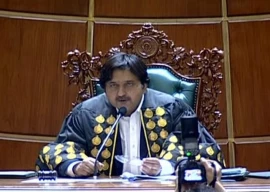
Divide and rule may be a dirty political strategy, but Pakistan’s human rights watchdog is arguing that perhaps this is the only way to govern Karachi - a city rent at the seams by ethnic, political, sectarian and financial polarisation.
The Human Rights Commission of Pakistan or HRCP has come up with a formula political parties could agree on. They need to make a decision fast, though, as the clock is ticking. A stopgap ordinance signed in by the governor to tide them over till the house of representatives met, will expire in November. If the parties don’t come up with new law, technically a disputed system from 1979 will return.
The proposal
Karachi could be divided into three districts with their own administrations, something that would mitigate the sense of deprivation in some ignored areas, said the HRCP on Wednesday.
Three towns could be two separate districts, Lyari-Keamari and Malir, and the remaining 15 towns could be lumped together under a Karachi district administration, explained Kaiser Bengali, who is the HRCP’s vice chairman for Sindh.
“The city already stands divided on linguistic lines,” he said at a press conference. “But let me assure you, we didn’t consider ethnicity while making this proposal. This suggestion is the result of our meetings with different stakeholders, including politicians.”
For its part, the HRCP has drafted a grass-roots governance system for Sindh that draws from the two choices at hand - the 1979 and 2001 local government ordinances. Ironically, these two laws were the brainchild of military dictators but are now being pursued by democratically elected parties.
The draft was prepared after the HRCP met leaders from the Pakistan Peoples Party (PPP), Muttahida Quami Movement (MQM) and other political parties, Bengali said. The proposal includes feedback from civil servants, who don’t want to be named, and prominent citizens.
The HRCP proposes a middle ground that would create small administrations answerable to the Sindh government. A divisional tier headed by a commissioner would control revenue and land management, law and order, disaster management and regional planning and development. A district local administration led by a nazim would manage finance and planning, works and services, schools, health, social welfare and community development.
The HRCP has also proposed that Sukkur, Larkana, Nawabshah, Mirpurkhas and other urban centres with a population between 250,000 and one million should have metropolitan corporation status. The status of Hyderabad would remain the same.
A Capital Town could be created within the limits of the Karachi City District Administration. This could cover Governor House, the chief minister’s residence, the Sindh Assembly, high court, Supreme Court, Commissioner House. The Sindh government would manage it.
Who gets the money?
Karachi used to be divided into five districts - South, East, Central and West - under the 1979 system. Under the 2001 system, it was then turned into one district with 18 towns. The complaint was, however, that the lucky nazims backed by certain political forces got funding and were able to manage their towns better than the nazims whose coffers were empty.
In the HRCP draft, the proposed Karachi district administration includes areas with major markets, corporate offices and relatively better-off households. Would this mean that this chunk would get more money? But the HRCP’s Kaiser Bengali felt that it would not matter too much as all districts would be evenly distributed money from the provincial finance commission. However, what if the MQM argued that Urdu-speaking areas earned more, and hence deserved more spending money? “These details can be sorted out,” said Bengali. “As it is, funds are being divided on the basis of contribution, population and other parameters.”
Karachi’s budget of over Rs70 billion depends mostly on its own resources. Most of the revenue is collected through local taxes like the property transfer and outdoor advertisement levy.
MQM seeks reconciliation
Former naib nazim of Karachi and an MQM leader Nasreen Jalil told The Express Tribune that her party was ready to talk about reshaping the Local Government Ordinance of 2001. “We are open to changes as long as it serves the interest of citizens,” she said.
Public representatives must be elected from the grass-roots level, she said, referring to the MQM’s stand. These decisions have to be made, however, by a core committee of political parties. According to another senior MQM leader, who requested anonymity, a draft bill has already been submitted to the PPP.
ANP to resist tooth and nail
Aside from the PPP and MQM, another player on Karachi’s scene is the Awami National Party with two MPAs. But it is unhappy that so far it has not been consulted on these laws. “The ANP is not against the local government system but the way it is run in Karachi is unacceptable,” ANP MPA Ameer Nawab told The Express Tribune. For one, the party wants an assessment of the way the money was spent in neighbourhoods. “Billions of rupees were transferred to the Karachi administration and the MQM spent all of it on its own constituencies,” he alleged.
PPP and the 1979 system
The PPP, which holds sway in the Sindh government and wants the 1979 system, has painfully watched its ministers sit on the sidelines on city government matters. The problem was that its ministers did not have administrative clout under the 2001 system, favoured by the MQM. The PPP ministers had to give in to the more powerful district nazims who could order the construction of roads, make appointments to schools and take other financial decisions.
This was why the PPP preferred a 1979-like system as it gave more authority to the Sindh chief minister and the people he appointed.
There was a downside to investing so much power in the nazims (under the 2001 system). “There is also a concern that in parts of Sindh, nazims have created their serfdoms,” said Bengali. “But the MQM insists on having all the powers with the local administrations.” The HRCP wants to see the PPP and MQM agree on a hybrid as both systems have their pros and cons.
PPP least bothered
As the debate on local government started cooking, the PPP’s Zulfiqar Mirza, who resigned as an MPA, vowed that he would fight the MQM on the 2001 system. He claimed that he had the backing of PPP MPAs - whose vote could be crucial to have the bill either passed or rejected in the Sindh Assembly. This became uncomfortable for the party that recently welcomed the MQM back as a coalition partner.
The PPP’s Sharmila Farooqui argued that it did not matter if some MPAs backed Mirza. All a bill needs is a two-thirds majority. “In the house of 168 MPAs, a dozen or so votes of opposition don’t matter,” she said. Out of the 168 members, PPP has 100 MPAs while the MQM holds 52 seats. The Pakistan Muslim League-F has eight members and the rest belong to smaller parties.
PML-F favours commissionerate system
For its part, the PML-F has categorically stated that it is against the 2001 system. “A few changes could be made to the [1979] commissionerate way of governance,” said the party’s Imtiaz Sheikh. “That is acceptable to us. But we want the district coordination officers to run affairs.”
Published in The Express Tribune, October 13th, 2011.


















COMMENTS
Comments are moderated and generally will be posted if they are on-topic and not abusive.
For more information, please see our Comments FAQ